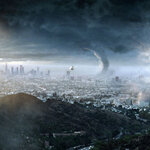Atmospheric

Transport accounts for an up to 30% of CO2 emissions in the EU, with estimates claiming that emissions from that sector rose 36% between 1990 and 2007.
A new analysis conducted by Lund University and the University of Surrey takes on the widely-held view that new technologies, such as biofuel and improved aircraft design, will result in carbon reduction targets being met.
In their paper, the scholars note that policy makers are turning to the perceived benefits of those technologies to drive decarbonization policy, though evidence is just as lacking for them as there is for…

Dusty air blowing across the Pacific from Asia and Africa is playing a critical role in precipitation patterns throughout the drought-stricken western U.S.
The exact chemical make-up of that dust, including microbes found in it, is the key to how much rain and snow falls from clouds throughout the region and knowing this could help better predict rain events, as well as explain how air pollution from a variety of sources influences regional climate in general.
"We've learned that not all of the particles in the air at high altitudes have the same influence on clouds. We're starting to think…

Weather extremes have been linked to a recently discovered mechanism: the trapping of giant waves in the atmosphere.
A new data analysis now shows that such wave-trapping events are indeed on the rise. One reason could be changes in circulation patterns in the atmosphere. By analyzing large sets of global weather data, the researchers found an intriguing connection.
Rossby Waves: meandering airstreams
An important part of the global air motion in the mid-latitudes normally takes the form of waves wandering around the globe, called Rossby Waves. When they swing north, they…

The Intergovernmental Panel on Climate Change (IPCC), a United Nations geographically-chosen group of climate researchers, is the most high-profile science body in the world. Publicly they state that short-term weather events not be linked to climate change, since if every heat wave is called proof of global warming, every snowstorm will be called proof against it.
Despite UN cautions, numerous papers still link short-term weather events to climate change. In Climate Dynamics,
Florida State University geography professor
James Elsner and colleagues write that they have proved that climate…

In California, wildfires happen thousands of times per year, even in non-drought years. They happened long before climate change concerns but not factoring wildfires into simplistic parameter-based models of climate change meant we were not getting an accurate picture of the atmospheric reality.
Scientists have uncovered key attributes of so-called "brown carbon" from wildfires, airborne atmospheric particles that may have influenced current climate models that failed to take the material's warming effects into account. Black carbon or soot that absorbs sunlight at all wavelengths is a well-…

NASA's Tropical Rainfall Measuring Mission satellite known as TRMM flew directly over the eye of powerful Hurricane Iselle and found extremely heavy rainfall rates occurring there.
On August 4, 2014 at 1037 UTC (6:37 a.m. EDT) when TRMM passed over the storm, Iselle had winds of about 120 knots (about 138 mph) at that time making it a dangerous category four hurricane on the Saffir-Simpson hurricane wind scale. Rainfall from TRMM's Microwave Imager (TMI) and Precipitation Radar (PR) instruments was overlaid on an enhanced infrared image from NOAA's GOES-West satellite that showed cloud extent…

Sulfur signals in the Antarctic snow have revealed the importance of overlooked atmospheric chemistry for understanding climate, past and future.
The element sulfur is everywhere and occurs in four stable forms, or isotopes, each with a slightly different mass. Ordinary reactions incorporate sulfur isotopes into molecules according to mass. But sometimes sulfur divvies up differently so that the relative ratios of the different isotopes is anomalous. The authors of a new paper measured the direction and degree of that anomaly for individual layers of snow representing a single season's…

Climate models predicted that the equatorial Pacific trade winds should weaken with increasing greenhouse gases, yet satellites and climate stations have instead revealed a rapid and unprecedented strengthening of the Pacific trade winds since the 1990s.
A new model explains the eastern Pacific cooling as resulting solely from natural climate variability, the international climate research team points to a climate feedback that has been overlooked, namely, that the recent Atlantic warming affects the atmospheric circulation over the Pacific, leading to an increased persistence of cold…

It has long been known that biomass burning – burning forests to create agricultural lands, burning savannah as a ritual , slash-and-burn agriculture and wildfires – figures into both climate change and public health but the degree of that contribution had never been comprehensively quantified and when science gets political, people may not always want to discuss the complete set of issues.
As policy expert Dr. Roger Pielke, Jr. discovered during a brief stint with the politically-motived FiveThirtyEight.com group, science is often only welcome if it agrees with the cultural slant of the…

One of the most promising aspects of a Science 2.0 future is not just being able to analyze trillions of data points or getting the public to help with biology, but making more accurate models using much larger data sets. Big data.
This is not new in commercial physics software, where a Monte Carlo analysis stopped being how products were made by the mid-1990s. If a semiconductor company is going to tape out a product, they want accurate models and that is why physics and engineering were among the rare tools that got less bloated and faster as computing power increased. But it's new for…